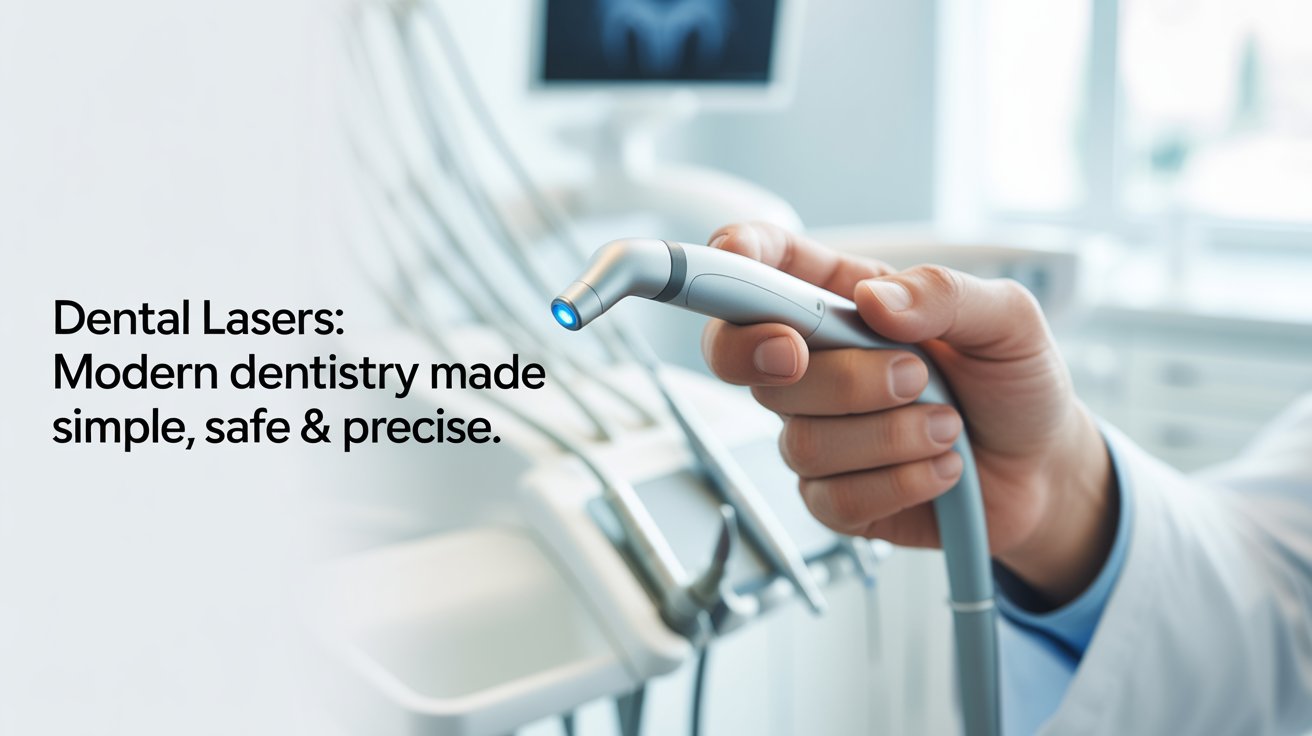
Dental Laser Dentistry Explained: Real Benefits, Uses, Safety
A lot of people hear the term dental laser and imagine some futuristic Star Wars tool.
But honestly, when you see one inside a clinic, it looks pretty normal. Small. Clean. Quiet. And surprisingly, patients react to it very differently than they react to a drill.
Let me try to explain lasers the way dentists usually talk about them in real life, not in textbook language.
What a Dental Laser Actually Is
Instead of cutting with a blade or drilling with a spinning bur, the laser uses a focused beam of light.
Different lasers do different things:
- Diode lasers → mostly for gums
- Erbium lasers → these can work on the tooth surface
- CO₂ → more for surgical soft-tissue cutting
You don’t need to know the physics behind it to understand how it feels.
What matters is: the tool touches less and disturbs less.
Why So Many Dentists Are Switching
Every dentist I know who bought a dental laser says one thing:
“My patients don’t complain anymore.”
I’ve seen this myself during procedures:
- The patient doesn’t flinch.
- There’s hardly any bleeding.
- The dentist isn’t wiping instruments or changing burs every minute.
- The room is quieter.
It’s a calmer experience for everyone.
Lasers vs Drills: The Real Difference You Notice
A drill has a sound that can ruin your entire mood even before the dentist touches your tooth.
A laser… doesn’t do that.
You hear a soft beep sometimes, but that’s about it.
For cavities
Patients don’t feel the pressure or vibration. Kids, especially, tolerate it far better.
For gum surgeries
The difference is huge.
I’ve seen gum procedures where the tissue barely bleeds. The patient gets up and asks, “That’s it?” No sutures. No messy gauze.
Where Lasers Are Actually Used
Not all dentists use lasers the same way, but these are common:
- Cleaning up infected gum pockets
- Removing a small flap or frenum
- Whitening
- Shaping gums to fix a smile
- Opening a small cavity on the side of a tooth
- Disinfecting inside a root canal
The biggest plus is precision.
You cut exactly where you intend to, not a millimeter extra.
Are Lasers Safe?
Yes, and honestly, safer in many cases because they sterilize as they work.
The only real “risk” is misuse, but that’s true for every dental instrument.
Most patients feel:
- a warm sensation
- maybe mild soreness afterward
- very rarely, light swelling
Compared to scalpel surgery or drilling, the discomfort is almost nothing.
How to Choose a Good Laser Dentist
Don’t judge by the machine.
Judge by the person using it.
Things that matter:
- Does the dentist explain the procedure without rushing you?
- Do they show before/after photos of previous laser cases?
- Do they actually use the laser consistently, not once in a while?
- Are they comfortable handling it or do they look hesitant?
A confident operator makes a big difference.
Patients’ Reactions
These are the three most common reactions I’ve personally heard:
“That was way easier than I expected.”
“I didn’t even feel it starting.”
“My gums healed faster this time.”
When multiple patients say the same types of things, you know there’s something real going on.
What About the Cost?
Laser treatments sometimes cost a bit more, but here’s the funny truth:
Patients rarely complain once they’ve tried it.
You save:
- time
- extra visits
- post-op pain
- long healing periods
So the value balances out.
Is Laser Dentistry the Future?
If you ask dentists who already use it, most of them say yes.
The tech is improving fast, especially the hard-tissue lasers.
In the next few years, we’ll probably see:
- faster cutting
- more accurate wavelengths
- smaller devices
- more clinics using them routinely
It won’t replace drills entirely, but it will definitely share the stage.
Final Thoughts
Laser dentistry isn’t magic. It won’t solve every dental problem.
But in situations where it works well, it makes life easier for both sides of the chair. The procedures feel calmer, cleaner, and honestly… more modern. If you’re a patient curious about it, ask your dentist.
If you’re a dentist thinking about adding lasers, try watching a few real procedures you’ll understand why the shift is happening.
👉 Shop for dental products with Shop4Smile – powered by ABA Technologies.

Leave a Reply